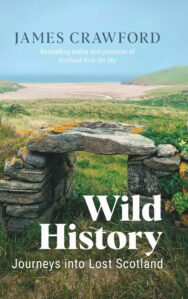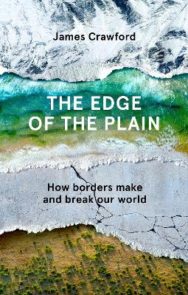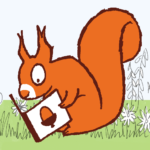‘Perhaps more than anything else, I want my book to be an invitation. An invitation to see for yourself just how much of the past still lives with us in the present.’
James Crawford explores the places others overlook in his latest book, a book that is both fascinating and beautiful. Here, he introduces us to his aims in making his journeys and writing his Wild History.
Wild History: Journeys into Lost Scotland
By James Crawford
Published by Birlinn
How can history be wild? Well, in one sense, it can’t. Wilderness – true wilderness – means somewhere unaltered by human activity. Today, very few wild environments can be found anywhere on Earth. And arguably, even where they can, the scale and extent of human-influenced climate change has filled the very atmosphere, or seas, or soils around them. This is the product of the Anthropocene, the ‘human time’ – the name that has been given to our newest geological era, conceived to acknowledge that the presence and influence of people is no longer just something written on the surface of the Earth but has become woven irrevocably into the very fabric of the planet.
Scotland long ago lost any claim to true wilderness. Since the end of the last Ice Age, some 10,000 years ago, this land has been moved through, occupied, cut up, cut down, dug out, built on and entirely changed. No parts – even those areas that are perceived as the most ‘extreme’ or ‘remote’ – have been left untouched by people. What has happened to our landscape is an accumulation. Of interventions, of events, of life. It began with hunters stalking their prey north and killing and cooking on land that we now call Scotland. In the process they left behind simple piles of shells and bones in rubbish pits known as middens – fish bones, deer antlers, hazelnut kernels. The scorch marks of the millennia-old fires that they lit, the hearths that they gathered around, have persisted, in the depths of the loam, all the way up to the present day.
As time passed, these traces – so faint and fragmentary at first – built inexorably. Much was destroyed or erased or lost. But not everything. The not everythings from one era merged with the not everythings from another. The fires stopped moving, the walls around them grew solid, the accumulation intensified and accelerated. Ploughshares started to rip up the ground. Axes – and a colder, wetter, windier climate – began to clear the forests. Bit by bit, communities overspread the land, turning the wilderness to their own ends.
The result is that, today, we live entirely among the physical impression and presence of the past. Often it emerges in the shapes of our towns and cities; in the ways our fields look; in the bare reaches of our sheep-wandered hills and moorlands. Just as before, so much has been destroyed or erased or lost. But at the same time, the list of the not everythings from successive periods has grown vast. Some have even been afforded special status, segregated from the present to be offered up as preserved, curated ruins and tourist attractions; even adopted as national icons. A handful receive millions of visitors each year.
But the majority do not. Rather, they exist in a state of continually fading obscurity, spread out across those parts of the landscape which people once knew, but now, largely, don’t. They are what this book is about. The un-curated and the ignored, the unfiltered and the abandoned. Those places that are not wilderness, but rather feel post-human: the shadows of people’s lives in the landscape, sometimes growing faint, but still persisting. They are what I mean by ‘wild’ history. History set adrift, let loose, let go. History, in some sense, set free. Just there: overgrown, overlooked – and increasingly untamed.
A few years ago, I began travelling out into the landscape to see some of these sites for myself. They include a 2,500-year-old hole in the ground found on a lonely knoll in Sutherland, leading down into what may be Scotland’s oldest surviving basement. Colossal ancient border markers delimiting the boundaries of long extinct kingdoms. Drowned roads and fading drove roads. Beached shipwrecks and rhododendron-choked modernist wrecks. Medieval deer traps and prehistoric cattle ranches. Lost valleys and lost villages. Pictish ‘cities’, Viking boat-burials, a shrine to the goddess of winter and a stone circle surrounding a three-millennia-old lightning strike. A Roman signal station, a concrete hermit’s castle and the regrowing ruins of a cathedral made of trees. A moorland on the cusp of the Highlands that once served as a surrogate for Gallipoli. Five miles of beach and tidal sands studded with the bone-bleached uprights of over 2,000 wooden poles.
Perhaps more than anything else, I want my book to be an invitation. An invitation to see for yourself just how much of the past still lives with us in the present. An invitation to explore the unexplored and make pilgrimage to the lost and overlooked. An invitation to ‘use the country itself, as its own map’ – and to see where it will take you.
Here are some of the places you can discover:

Clach na Briton, Glen Falloch – a colossal ancient border marker delimiting the boundaries of three long extinct kingdoms

Tigh na Cailleach, Glen Lyon – a still active shrine to the goddess of winter

Hermit’s Castle, Achmelvich Bay

Cracking Souterrain, Sutherland – a 2,500-year-old hole in the ground found on a lonely knoll in Sutherland, leading down into what may be Scotland’s oldest surviving basement.

The Old Fish Road to Ullapool, revealed beneath the waters of Loch Glascarnoch

Ben Griam Beat, Sutherland – the site of Scotland’s highest hill-fort? Or perhaps the ruins of a prehistoric cattle ranch, abandoned due to a cooling climate over 3,000 years ago

The modernist ruins of Cardross Seminary

The ‘lost village’ of Lassodie in Fife, a one time coal mining community that has been completely erased and now partially ‘re-wilded’
Wild History: Journeys into Lost Scotland by James Crawford is published by Birlinn, priced £22.00.
ALSO IN THIS ISSUE
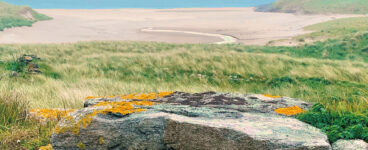
 Wild History: Journeys into Lost Scotland
Wild History: Journeys into Lost Scotland
‘Perhaps more than anything else, I want my book to be an invitation. An invitation to see for yours …
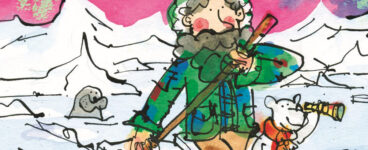
 Uncle Pete and the Polar Bear Rescue
Uncle Pete and the Polar Bear Rescue
‘“We’re going to have to jump out!” yelled Uncle Pete, hoping he’d packed his parachute and not his …





